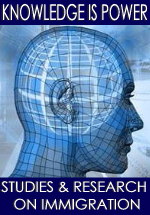The Pew Hispanic Center today released its newest report on the unauthorized migrant population . Size and Characteristics of the Unauthorized Migrant Population in the U.S. contains the most current information on the estimated 11.5 to12 million unauthorized migrants living and working in the US.
Analysis of the March 2005 Current Population Survey shows that there were 11.1 million unauthorized in the United States a year ago. Based on analysis of other data sources that offer indications of the pace of growth in the foreign-born population, the Center developed an estimate of 11.5 to 12 million for the unauthorized population as of March 2006.
In the March 2005 estimate two-thirds (66%) of the unauthorized population had been in the country for ten years or less, and the largest share, 40% of the total or 4.4 million people had been in the country five years or less. There were 5.4 million adult males in the unauthorized population in 2005, accounting for 49% of the total. There were 3.9 million adult females accounting for 35% of the population. There were 1.8 million children who were unauthorized, 16% of the total. In addition, there were 3.1 million children who are U.S. citizens by birth living in families in which the head of the family or a spouse was unauthorized.
About 7.2 million unauthorized migrants were employed in March 2005, accounting for about 4.9% of the civilian labor force. They made up a large share of all workers in a few more detailed occupational categories, including 24% of all workers employed in farming occupations, 17% in cleaning, 14% in construction and 12% in food
(much more below the fold)
Tag: immigration
What follows is the information from the executive summary of the report. The entire report can be read here.
Analysis of the March 2005 Current Population Survey shows that there were 11.1 million unauthorized in the United States a year ago. Based on analysis of other data sources that offer indications of the pace of growth in the foreign-born population, the Center developed an estimate of 11.5 to 12 million for the unauthorized population as of March 2006.
Size and Characteristics of the Unauthorized Migrant Population
Estimates Based on the March 2005 Current Population Survey
- Since 2000, growth in the unauthorized population has averaged more than 500,000 per year. Based on evidence that this trend has persisted, the current unauthorized population can be estimated at between 11.5 and 12 million.
- In the March 2005 estimate two-thirds (66%) of the unauthorized population had been in the country for ten years or less, and the largest share, 40% of the total or 4.4 million people had been in the country five years or less.
- Unauthorized migrants accounted for 30% of the foreign-born population in 2005. Another 28% were legal permanent residents, and 31% were U.S. citizens by Naturalization
- Most of unauthorized migrants came from Mexico. There were an estimated 6.2 million unauthorized Mexican migrants in 2005, or 56% of the unauthorized population.
- About 2.5 million unauthorized migrants, or 22% of the total, have come from the rest of Latin America, primarily from Central America. Unauthorized migrants from Mexico and the rest of Latin America represented 78% of the unauthorized population in 2005.
- Between 2000 and 2005 the number of unauthorized migrants from Mexico increased by about 1.5 million. Other large increases occurred among unauthorized migrants from Central America (+465,000) and South and East Asia (+365,000).
Family Characteristics
- There were 5.4 million adult males in the unauthorized population in 2005, accounting for 49% of the total. There were 3.9 million adult females accounting for 35% of the population. In addition, there were 1.8 million children who were unauthorized, or 16% of the total.
- Among adults, males make up 58% of the unauthorized population while females make up 42%
.
- As of 2005, there were 6.6 million families in which either the head of the family or the spouse was unauthorized. These unauthorized families contained 14.6 million persons.
- Nearly two-thirds (64%) of the children living in unauthorized families are U.S. citizens by birth, an estimated 3.1 million children in 2005.
Labor Force Characteristics
- Unauthorized migrants accounted for about 4.9% of the civilian labor force in March 2005, or about 7.2 million workers out of a labor force of 148 million.
- Unauthorized workers are employed in a variety of occupations, although the distribution of the unauthorized workforce across occupations differs from that of native-born workers. For example, nearly a third (31%) of
unauthorized workers were employed in service occupations compared to one-sixth (16%) of native workers in March 2005. Unauthorized migrants are underrepresented in white-collar occupations.
- About 19% of unauthorized workers were employed in construction and extractive occupations, 15% in production, installation and repair and 4% in farming.
- Unauthorized migrants make up a large share of all workers in a few more detailed occupational categories. They were 24% of all workers employed in farming occupations, 17% in cleaning, 14% in construction and 12% in food preparation industries. Within those categories, unauthorized workers were a very large share of all workers in certain specific occupations. For example,
the unauthorized were 36% of all insulation workers and 29% of all roofers and drywall installers, 27% of all butchers and other food processing workers.
- The concentration of unauthorized workers in broad industries is not as marked as the concentration in broad occupation groups. Only in “leisure & hospitality” and in “construction” does the share of unauthorized workers greatly exceed the share of natives. About 1 in 5 unauthorized workers was in the construction industry (20%) and 1 in 6 was in the leisure & hospitality
industry (17%). Only about 7%–8% of native workers was in each of these industries.
- There are fewer detailed industries with high concentrations and significant numbers of unauthorized workers than detailed occupations. Nonetheless, there are some industries with substantial concentration of unauthorized workers. The unauthorized were 21% of the workers in private household industries. They were between 12% and 14% of all the workers in food manufacturing, farming, furniture manufacturing, construction, textiles, and food services.
for more from the Pew Hispanic Center

































No comments:
Post a Comment